This page provides information on the impact of the MS Oliva Wreck
on Tristan's Economy & Environment
from September 2011
including news of a final insurance settlement in September 2012
Start from the beginning or go straight to the Latest News Bulletin
|
Report from Administrator Sean Burns on 13th October 2011
MS Oliva Wreck
Experienced Divers Sue Scott and Geoff Fridjhon have been here for the last three weeks looking at the wreck and the marine environment. They report that, as predicted, the wreck is breaking up and that there is already a considerable amount of growth on the structure. They saw no oil and only some soya. Oil on the rocks around the coast has been washed away. They did, however, find soya rotting in the deeper water where the currents and wave action cannot clear it out. We will continue to monitor this as and when we can. We hope that another vessel with proper equipment aboard will be here in the coming weeks to survey both the wreck and the seabed. The aim will be to establish what is left on board in terms of pollutants, toxins and cargo and study the deeper water.
Penguins
The conservation team are in the process of doing the annual counts and early indications are encouraging. We will publish more once we have the results in and they have been properly analysed.
Fishery
The fishery on Inaccessible is open for a limited tonnage pending decisions we need to take following work we are doing with our experts, on the impact the Oliva has had on the fishing grounds there. Nightingale remains closed pending further surveys and test fishing (which has so far been poor). The main worry continues to be what impact there has been on the juvenile lobsters and therefore, recruitment in to the fishery in future years. We are working very closely with our experts, Ovenstone and the owners/insurers to try and establish this and what we need to do to counter this. Work is progressing on this. As you will appreciate, this is a complex area and needless to say, as always, we need to adopt a cautious approach to protect our most valuable resource.
See also fishing reports on the 2011 Fishing News Page
|
Sue Scott reports on her MS Oliva dives in September 2011
(Text first published in the February 2012 Tristan Newsletter)
|
| Six months after the wreck, diving surveys near the remains of the cargo section found almost no urchins in an area where they were previously abundant. Mass smothering by the large quantities of soya spilled in the weeks following the wreck is suspected. In the absence of grazing urchins, large numbers of kelp sporelings had settled on rocks and on the wreck, making it difficult to detect any alien species that may have arrived with the ship. Few adult lobsters were seen. A site dived off southeast Stoltenhoff appeared normal, with abundant urchins. A large middle section of the ship was not found. |

|
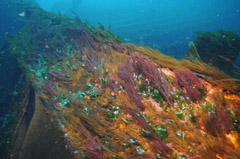
|

|
Photos from Sue Scott show
Below centre: Geoff Fridjhon exploring MS Oliva’s bow area;
Below Right: A dead 'sump' area where soya lay at a depth of 20 metres,
smothering and killing urchins and other marine life, though now the soya has washed away.
Other photos show the fast growth of Tristan seaweeds on the wreck after only six months.
|
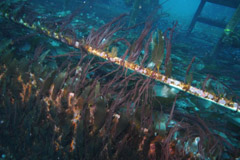
|
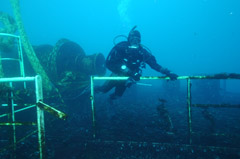
|

|
No soya was seen on the seabed to 30m, although there were dead 'sumps' where soya had been lying. Soya fragments were often seen suspended in the water, and beans were also still visible floating in the water between Nightingale and Tristan. Rotting beans were dredged from 124m off southwest Nightingale, together with dead bryozoans and sponges, in an area where lobster traps stained black had been reported previously. These beans are obviously still causing anoxic conditions on the seabed; the extent of this damage is unknown. |
|
Administrator Sean Burns reviews MS Oliva clean-up progress
Extracts from Sean's article in the February 2012 Tristan Newsletter
|
Effect on Fishing
We continue to engage with the owners, insurers and our own experts, but we were becoming increasingly concerned about the effect the 65,000 tonnes of soya beans were having on the lobster grounds. Even though it had been some time since we had seen any oil, we were still seeing soya around Nightingale. Evidence from the test fishing showed that catches were way below normal and we were seeing rotting soya on the traps. Our own dredging experiments told us that there was soya settling and rotting on the seabed.
We were also faced with decisions about the quota for the 2011/12 season. MARAM, the experts at the University of Cape Town who advise us on the annual quotas, conducted two exercises. The first was to set a quota as though the Oliva had never grounded and the second, post-Oliva, took account of what the soya and oil might have done to the fishery and how we should manage this. With the help of our own experts and in the absence of any other advice, Council decided to keep the Nightingale fishery closed and to reduce the Inaccessible quota from 92 to 53 tonnes for the 2011/12 season.
Counts of juvenile lobsters were made in the sub-tidal fringe, the zone where around Nightingale they are thought to live almost exclusively, and where oil will have its greatest impact. Numbers were higher on Tristan than on Nightingale or Inaccessible by a factor of 10 to 20, indicating an impact on juveniles. However this is based on small samples for Tristan and Inaccessible, so additional counts are needed from these islands before firm conclusions are drawn. Examination of small invertebrates in seaweed turf samples (potential juvenile lobster food) has not yet been completed. Food choice experiments on captive Tristan lobsters and urchins found that neither consumed soya, while lobsters ate the usual fish used for baiting traps. It was concluded that eating soya in favour of trap bait is not the reason for low lobster catches around Nightingale since the wreck.
|
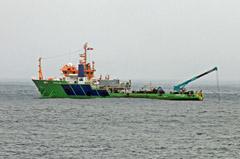
|
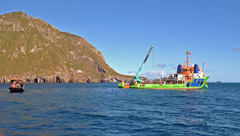
|

|
Photographs of the Fairmount Fuji vessel which carried out surveys around the wreck site of MS Oliva in December 2011
Left: From Peter Millington taken when the MS Island Sky cruise ship visited Nightingale Island on 23rd December
Centre and Right: From Sean Burns on 27th December |
Cape Town Workshop
In order to help us manage the fishery effectively a workshop took place in Cape Town between 16-18 November with positive engagement from all. The Tristan Government appointed an independent chair and there were representatives from MARAM, the TdC Government, the fishing company Ovenstone and experts and representatives from the owners/insurers. The first project to come out of the workshop is a juvenile lobster survey of Nightingale and Inaccessible. A team from Enviro-Fish Africa (EFA), linked to Rhodes University, arrived in January and with an island team managed by James Glass, will be surveying the juvenile lobster stocks to try and assess what impact the soya has had on them and therefore recruitment of stock into the fishery in the future. This will help inform us when we come to make decisions about the quotas in future years. So, although we still have plenty to keep us occupied and there are still many unknowns, I am pleased to report that progress is being made and I want to thank all the experts and advisers for their help with this.
Fairmount Fuji Wreck Survey
As for the wreck itself, the owners/insurers sent out a survey vessel (The Fairmount Fuji) over Christmas. There were teams from Titan (who were here for the oil rig removal), LOC (London Offshore Consultants), ADUS (Advanced Underwater Surveys) and Seaview Systems. They were here for two weeks and were joined by a small island team (James Glass, Jeremy Green, Warren Glass, Simon Glass and Wayne Swain) who participated fully in the survey and provided vital local knowledge. The teams made a survey of the area with sonar equipment and Remotely Operated Underwater Vehicles. We have not yet seen their report but they located both the fore and aft sections of the wreck and also looked for evidence of soya. It appears that the wreck continues to break up and we understand they found no evidence of soya on the seabed. Our concern remains whether there is still oil, other lubes and soya still trapped inside the wreck and soya rotting in the deeper water where it has settled. We hope this survey will give us some clarity on these important issues. |
|
Agreement reached with Owners and Insurers of the MS Oliva
Report from Administrator Sean Burns on 11th September 2012
I am pleased to report that we have finally reached an agreement with the owners/insurers of the MS Oliva, the bulk carrier that ran aground at Nightingale Island on 16 March 2011.
The details of the settlement are a commercial matter between the vessels owners/insurers and the Tristan Government but we are satisfied that the settlement represents a reasonable and fair deal for us to move forward with the management of the fishery and protection of the environment.
In the meantime the fishery at Nightingale remains closed and the quota at Inaccessible has been reduced to 44 tonnes. These are provisional quotas that will be reviewed at a meeting of fishery experts in Cape Town in November. James Glass, our Fisheries Director will be attending on Tristan’s behalf.
The Conservation Department will shortly begin the penguin counts around the islands and further details will be posted just as soon as they become available. |
|









